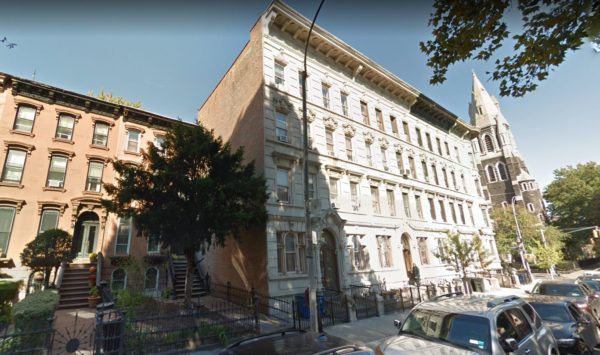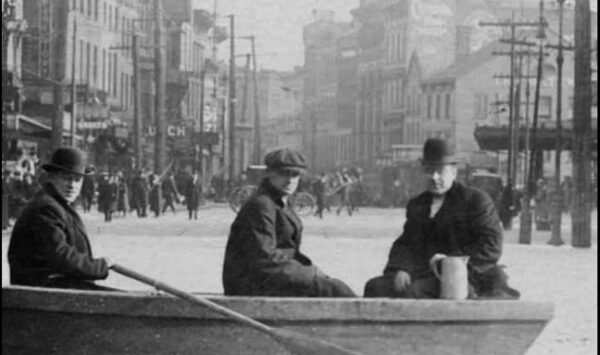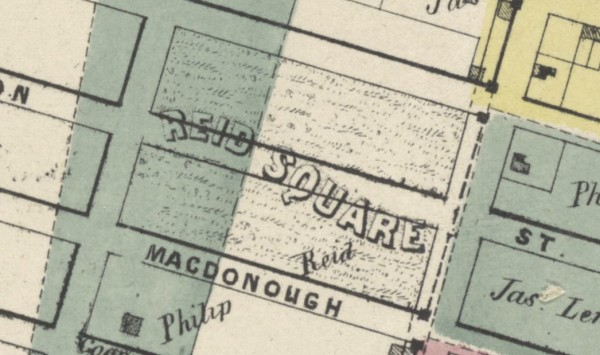A BUILDER, A BRIBE, & A BLOCKED VIEW (1904)

******************************************************************************************************************************** Brownstone Detectives investigates the history of our clients’ homes. The story you are about to read was composed from research conducted in the course of one of those investigations. Do you know the history of YOUR house? ******************************************************************************************************************************** After builder Chauncey G. Cozine had filed his building plans for a set of luxury apartment buildings to be constructed at the northwest corner of Throop Avenue and MacDonough Street, the neighbors were horrified to learn of the enormity of the structures. As a matter of fact, they were so taken aback at the prospect, that when they met to determine how to address the egregious assault on their homes, they dug deeply into their pockets – each of them as deep as he felt it was worth – to come up with a sum that, combined, would hopefully encourage Cozine to consider altering his designs. When Cozine received the offer, though, the 30-year-old builder answered the monetary plea with a curt one-word response. “No.” BEFORE THE FOUNDATIONS WERE EXCAVATED Before Cozine came along in 1904, the noble brownstone structures with their stately front gardens which sat along the north side of MacDonough Street, commanded unobstructed views up and down the street. From the front stoop of any of these structures, which belonged, incidentally, to some of the wealthiest residents of Stuyvesant Heights, could be seen rows of beautiful brownstone houses and the majestic churches of two different denominations. At the Tompkins end of the block, sat the Tomkins Avenue Congregational […]
THE GREAT BROOKLYN FLOOD OF 1903

******************************************************************************************************************************** Brownstone Detectives investigates the history of our clients’ homes. The story you are about to read was composed from research conducted in the course of one of those investigations. Do you know the history of YOUR house? ******************************************************************************************************************************** By 7 a.m. on Friday, 9 October 1903, the cellars all along Macon Street were completely inundated with water that was rising quickly toward the basement joists. Without let up, the turgid brown waters continued to pour into the homes through the under-stoop doorways until the floodwaters had reached the level of the basement windowsills, whereupon it then began to pour also through the windows and into the basement dining rooms. The Ocean Hill area, like much of Brooklyn, had fallen victim of the heavy rains that had been falling continuously for much of the night. All the residences along Hancock, McDonough, Macon, Decatur, Bainbridge and Chauncey Streets were so flooded that residents on the ground floor apartments discovered upon waking that they were forced to go to the second floors to escape the waters. “IN SARATOGA PARK…BENCHES WERE FLOATING ABOUT…” The paths in Saratoga Park, according to one newspaper account, “had become running streams and benches were floating about.” The nearby Putnam and Halsey streetcars stopped running, as “it was impossible to take on any passengers, as the water was as high as the seats.” Streets and sidewalks were submerged under several inches of water, and, eventually, furniture moving vans were pressed into service by the police to be used […]
THE LONG SLOW DEATH OF REID SQUARE (1870)

******************************************************************************************************************************** Brownstone Detectives investigates the history of our clients’ homes. The story you are about to read was composed from research conducted in the course of one of those investigations. Do you know the history of YOUR house? ******************************************************************************************************************************** Laid down by the Brooklyn street grid commissioners in the 1830s, Reid Square was a planned park that was to be comprised of two of Brooklyn’s city blocks in the Town of Bedford. Named after the owner of the farmland that the once-future park was to grace, Philip Reid, Reid Square never ended up being developed. The Square was to be bounded by Reid and Stuyvesant Avenues and Halsey and MacDonough Streets. Macon Street, which, for all intents and purposes, would have passed directly through the square at its center, was to be closed at that point. In 1869, however, as the park had been laid out but not improved, the Committee on Opening Streets of the Brooklyn City Common Council met and proposed a resolution to “draft an act to the Legislature to close Reid Square and lay down Macon Street from Stuyvesant to Reid aves.” This proposal was adopted and later in April of 1869, the Legislature passed the act, dooming Reid Square to an historical footnote. It is quite probable that powerful real estate speculators at the time forced the planned public square into its stillborn state, allowing the properties on these streets to be broken up into lots and then sold at auction for development purposes. Follow @BrownstoneDetec […]